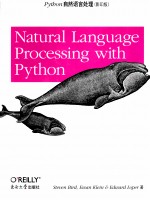

Python自然语言处理 英文版PDF电子书下载
- 电子书积分:15 积分如何计算积分?
- 作 者:(英)伯德,(英)克莱因,(美)洛普著
- 出 版 社:南京:东南大学出版社
- 出版年份:2010
- ISBN:9787564122614
- 页数:482 页
1.Language Processing and Python 1
1.1 Computing with Language:Texts and Words 1
1.2 A Closer Look at Python:Texts as Lists of Words 10
1.3 Computing with Language:Simple Statistics 16
1.4 Back to Python:Making Decisions and Taking Control 22
1.5 Automatic Natural Language Understanding 27
1.6 Summary 33
1.7 Further Reading 34
1.8 Exercises 35
2.Accessing Text Corpora and Lexical Resources 39
2.1 Accessing Text Corpora 39
2.2 Conditional Frequency Distributions 52
2.3 More Python:Reusing Code 56
2.4 Lexical Resources 59
2.5 WordNet 67
2.6 Summary 73
2.7 Further Reading 73
2.8 Exercises 74
3.Processing Raw Text 79
3.1 Accessing Text from the Web and from Disk 80
3.2 Strings:Text Processing at the Lowest Level 87
3.3 Text Processing with Unicode 93
3.4 Regular Expressions for Detecting Word Patterns 97
3.5 Useful Applications of Regular Expressions 102
3.6 Normalizing Text 107
3.7 Regular Expressions for Tokenizing Text 109
3.8 Segmentation 112
3.9 Formatting:From Lists to Strings 116
3.10 Summary 121
3.11 Further Reading 122
3.12 Exercises 123
4.Writing Structured Programs 129
4.1 Back to the Basics 130
4.2 Sequences 133
4.3 Questions of Style 138
4.4 Functions:The Foundation of Structured Programming 142
4.5 Doing More with Functions 149
4.6 Program Development 154
4.7 Algorithm Design 160
4.8 A Sample of Python Libraries 167
4.9 Summary 172
4.10 Further Reading 173
4.11 Exercises 173
5.Categorizing and Tagging Words 179
5.1 Using a Tagger 179
5.2 Tagged Corpora 181
5.3 Mapping Words to Properties Using Python Dictionaries 189
5.4 Automatic Tagging 198
5.5 N-Gram Tagging 202
5.6 Transformation-Based Tagging 208
5.7 How to Determine the Category of a Word 210
5.8 Summary 213
5.9 Further Reading 214
5.10 Exercises 215
6.Learning to Classify Text 221
6.1 Supervised Classifcation 221
6.2 Further Examples of Supervised Classification 233
6.3 Evaluation 237
6.4 Decision Trees 242
6.5 Naive Bayes Classifiers 245
6.6 Maximum Entropy Classifiers 250
6.7 Modeling Linguistic Patterns 254
6.8 Summary 256
6.9 Further Reading 256
6.10 Exercises 257
7.Extracting Information from Text 261
7.1 Information Extraction 261
7.2 Chunking 264
7.3 Developing and Evaluating Chunkers 270
7.4 Recursion in Linguistic Structure 277
7.5 Named Entity Recognition 281
7.6 Relation Extraction 284
7.7 Summary 285
7.8 Further Reading 286
7.9 Exercises 286
8.Analyzing Sentence Structure 291
8.1 Some Grammatical Dilemmas 292
8.2 What's the Use of Syntax? 295
8.3 Context-Free Grammar 298
8.4 Parsing with Context-Free Grammar 302
8.5 Dependencies and Dependency Grammar 310
8.6 Grammar Development 315
8.7 Summary 321
8.8 Further Reading 322
8.9 Exercises 322
9.Building Feature-Based Grammars 327
9.1 Grammatical Features 327
9.2 Processing Feature Structures 337
9.3 Extending a Feature-Based Grammar 344
9.4 Summary 356
9.5 Further Reading 357
9.6 Exercises 358
10.Analyzing the Meaning of Sentences 361
10.1 Natural Language Understanding 361
10.2 Propositional Logic 368
10.3 First-Order Logic 372
10.4 The Semantics of English Sentences 385
10.5 Discourse Semantics 397
10.6 Summary 402
10.7 Further Reading 403
10.8 Exercises 404
11.Managing Linguistic Data 407
11.1 Corpus Structure:A Case Study 407
11.2 The Life Cycle of a Corpus 412
11.3 Acquiring Data 416
11.4 Working with XML 425
11.5 Working with Toolbox Data 431
11.6 Describing Language Resources Using OLAC Metadata 435
11.7 Summary 437
11.8 Further Reading 437
11.9 Exercises 438
Afterword:The Language Challenge 441
Bibliography 449
NLTK Index 459
General Index 463
- 《自然拼读背单词 高考英语3500词》宋德伟 2019
- 《卓有成效的管理者 中英文双语版》(美)彼得·德鲁克许是祥译;那国毅审校 2019
- 《程序逻辑及C语言编程》卢卫中,杨丽芳主编 2019
- 《幼儿园课程资源丛书 幼儿园语言教育资源》周兢编 2015
- 《AutoCAD 2018自学视频教程 标准版 中文版》CAD/CAM/CAE技术联盟 2019
- 《跟孩子一起看图学英文》张紫颖著 2019
- 《高等学校“十三五”规划教材 C语言程序设计》翟玉峰责任编辑;(中国)李聪,曾志华,江伟 2019
- 《AutoCAD机械设计实例精解 2019中文版》北京兆迪科技有限公司编著 2019
- 《音乐语言的根基》张艺编著 2019
- 《认知语言学视野的抽象方位结构研究》曹爽著 2019
